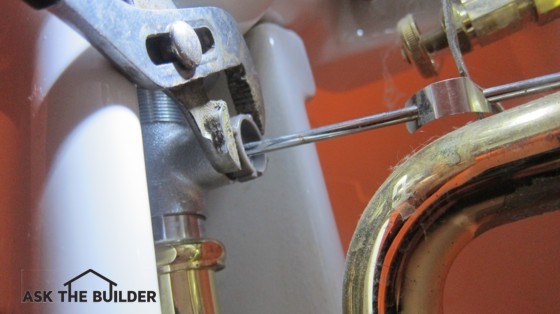How To Clear a Clogged Bath Sink Drain
Quick Column Summary:
- Unclog sink drain without chemicals
- Start with pliers
- How to remove stopper and clean it
DEAR TIM: For a month, it’s been taking longer and longer for the water to drain from my bathroom sink. This morning the murky water is just standing there not budging and defying my commands to exit my world and travel into the hidden plumbing pipes. I tried to pull out the stopper, but it only comes up so high and stops. I’m sure if I could pull it out, I’d solve the problem. Do you think I can get the drain unclogged? Do I have to use toxic chemicals? Do I have to take apart the sink trap? Teresia M., Orlando, FL
DEAR TERESIA: There’s a really good chance I’m going to save you some sweet moola. All you need is one simple tool. I’m hoping you have a simple adjustable pliers in your toolbox. This tool will allow you to remove the nut and lever arm that’s holding the sink stopper in place. I doubt you’ll have to take apart the p-trap under the sink. Many people fear this part of the drain line as it always leaks when they reassemble it.
I’ve been a master plumber for nearly forty years and have unclogged countless drains. Some plumbers specialize in this service. In your case, since the slow drain problem has just happened in a month’s time, I suspect your clog is just a mass of hair hung up on the bottom of the sink stopper where it attaches to the lever arm that operates the stopper.

An adjustable pliers is often the only tool you need to clear a clogged bathroom sink drain saving you over $100. Photo Credit: Tim Carter
There are all sorts of gizmos and magic tools that are sold claiming they can unclog sink drains without removing the stopper. I’ve tried them and it’s like going fishing. You may catch a fish and you may not. The different tools have varying levels of success.
What I like about taking out the stopper is it usually only takes two extra minutes to do this and you have full access to the drain pipe as it leaves the bottom of the sink. Once the stopper is out of the way you can use a flashlight to really see what’s going on.
For you to remove the stopper, and the gross hunk of hair and stuff-I-prefer-not-to-tell-
If you happen to have a wet-dry vacuum, use it. If you don’t, employ a sponge and a bucket. Use rubber gloves to keep your hands dry. The vacuum does a great job because it can often get the water that’s in the vertical drain pipe too.
Once the water is out of the sink, lay on your back and look up at the underside of the sink. You’ll see a short metal rod that is sticking out of the back of the drain pipe. This rod is linked to the knob at your faucet that makes the sink stopper go up and down. When you unscrew the nut that’s surrounding this rod, it will be easy to pull the rod from the drain pipe. Do this and just let it hang. Some small amount of water may come from the pipe, so be prepared to catch it with an old rag.
You can now remove the stopper. Be prepared to be grossed out. There could be a massive slimy hairball attached to it. The stopper assembly will be black with mold and biofilm. If you have any cuts or sores on your hands, you really should wear rubber gloves. You don’t want this gross stuff touching any open cuts, wounds or sores.
If you want to test to see if the sink drains really well without the stopper, hair and gunk in place, you need to re-install the metal rod and the nut. For this test, you can just hand tighten it. I do this all the time. Turn on the water to the sink and it should flow readily down the drain never backing up.
If you’re satisfied the sink is draining well, you may want to do one more thing before you put the stopper back in place after you’ve cleaned it. If you have a bottle brush that’s got a diameter slightly larger than the diameter of the sink drain, I’d recommend you turn on the water to the sink and use the brush to clean the side walls of the vertical tailpiece drainpipe. Any biofilm on this pipe can cause odors and you might as well get it clean now with the stopper out.
Drain-cleaning chemicals can be harsh on plumbing fixtures and you. If you or someone tried to use the liquid cleaners and the stew is still in the sink, do NOT get this liquid on your skin or in your eyes. You must carefully remove and dispose of this toxic brew outdoors before your start to take apart the drain.
If you live in a house built before 1970, there’s a good chance you might have galvanized iron pipe as the branch arm drain line to the sink. Over time, these pipes tend to build up hard deposits that completely choke off the pipe. If this is what you’re faced with, you may have to replace that horizontal pipe between the sink and the vertical plumbing stack that connects to the building drain under your slab or your basement floor. This is a job for a professional.
Column 1025
12 Responses to How To Clear a Clogged Bath Sink Drain